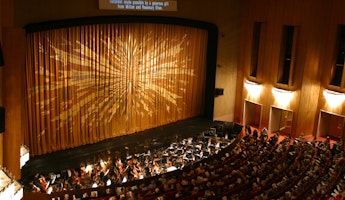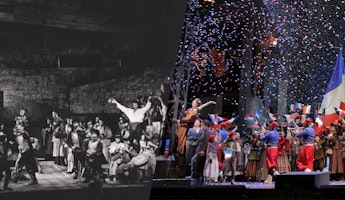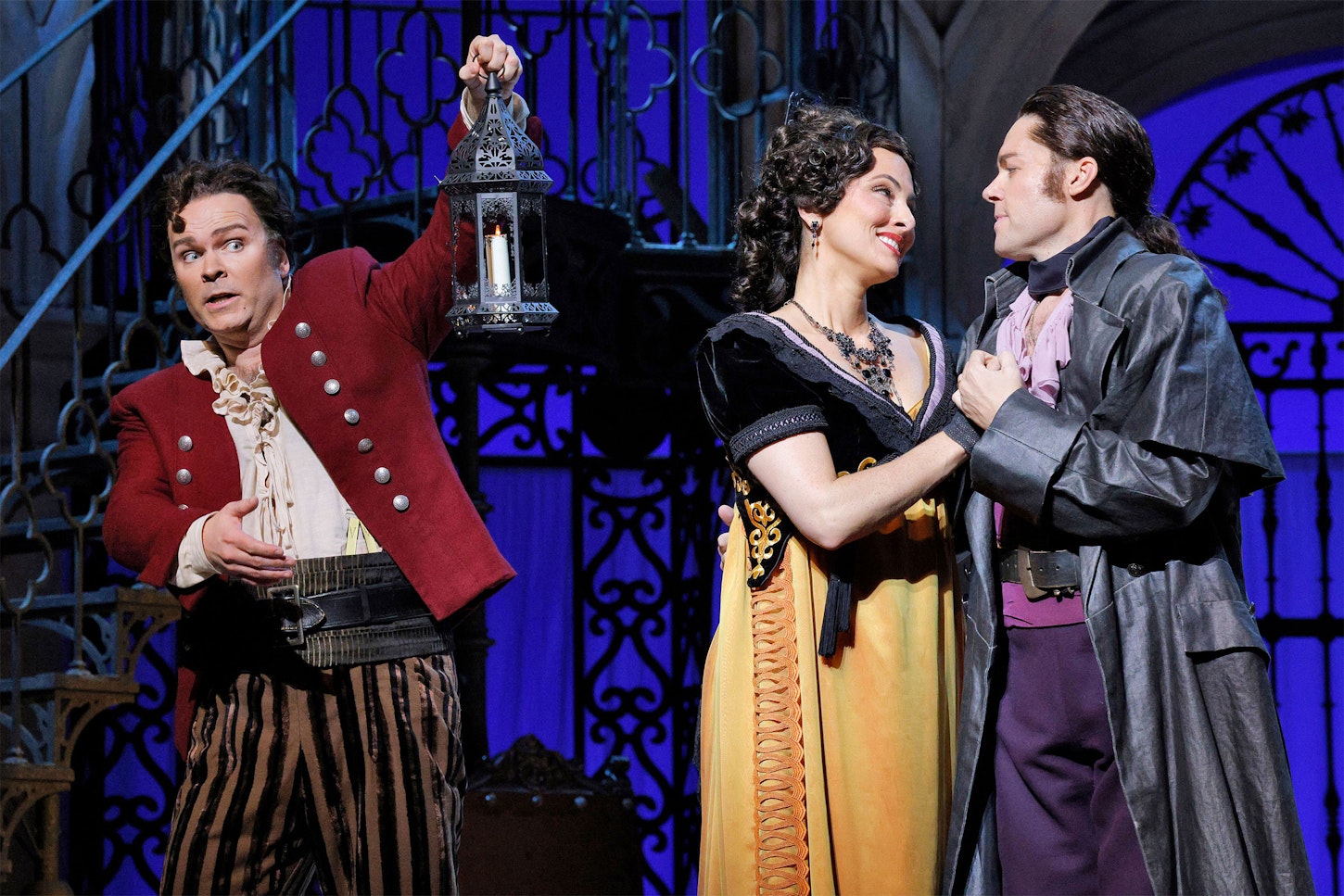Blog
October 15, 2023
Rossini and His Barber: "The Barber of Seville"
Quello che è l'amore per l'anima è l'appetito per il corpo. Lo stomaco è il maestro che dirige la grande orchestra delle nostre passioni. Mangiare, amare, cantare, digerire sono i quattro atti di quell'opera comica che è la vita.
[That which is love for the soul is the appetite of the body. The stomach is the maestro who conducts the grand orchestra of our passions. Eating, loving, singing, digesting; these are the four acts of the comic opera that is life.]
—Gioachino Rossini
Perhaps no other opera has permeated American culture as prodigiously as The Barber of Seville. From Bugs Bunny famously giving Elmer Fudd a shave in sync with the overture (as well as numerous other cartoon references ranging in era from Tom and Jerry to Hey Arnold!), to Robin Williams singing “Largo al factotum” at the beginning of Mrs. Doubtfire, to Robert Merrill pretending to be an ordinary barber with an extraordinary voice on Candid Camera, to a myriad of other references, the music of Rossini is quite likely to have been heard by those living in the United States at an early age. Indeed, Figaro’s self-aggrandizing repetition of his illustrious name is the symbol of all opera to a great portion of the population. And for those of us who love and cherish the art form, it remains a perennial favorite, just as effervescent and endearing today as it was 207 years ago.
In all honesty, however, it took until the second performance for Barber to be a resounding success, as its premiere on February 20, 1816, in Rome is remembered as one of the most famous operatic fiascos, a distinction it shares with La Traviata, Madama Butterfly and Carmen (all four of which enjoy total vindication today, being among the top ten of the most performed operas in the world, according to Operabase). The originating spark of the chaos was outrage over the perceived hubris of Rossini for trying to compose an opera whose text had already been set by the venerable Giovanni Paisiello. Rossini knew that this might very well be the case, and decided to name his opera Almaviva, o sia L’inutile precauzione [Almaviva, or The Useless Precaution]. This choice was supported by the fact that engaged to sing the role of the Count was one of the most celebrated tenors of his time, Manuel Garcia. However, Rossini almost always referred to it as Il barbiere di Siviglia in his writings, and so it very quickly became known as it also began to supplant its predecessor.
It is unsurprising that the man behind such a piece was himself a man of merriment, amusement and intrigue. Above all, he was a man who loved loving life, with a certain penchant for music and food. Marie-Antoine Carême, one of the pillars of French cuisine, was a friend, and created Le tournedos Rossini in the composer’s honor. Rossini’s bon vivant nature is the source of many such anecdotes and quotes. They show, among other attributes, his humor (“I have cried three times in my life: the first time my opera was booed, the first time I heard Paganini play, and the time a turkey stuffed with truffles fell into Lake Como on a boat trip”), his sprezzatura (“Give me a laundry list and I’ll set it to music”), his irreverence (“Oh how wonderful opera would be if there were no singers!”) and his wit (upon hearing Tannhäuser: “Wagner has lovely moments but awful quarters of an hour”). Once, when he was writing a piece while lying in his bed, a sheet of music fell to the floor, and rather than picking it up, he simply rewrote the music! Probably most vexing and imponderable was his decision to retire with the completion of Guillaume Tell at the age of 37 and the height of his powers. In the nearly 40 years that were left of his life, his fame only grew despite not another opera being offered to the public. He continued to compose pieces for himself and friends, his self-entitled “Péchés de vieillesse” [sins of old age], from which Les soirées musicales and the Petite messe solennelle in particular serve as testament that Rossini’s decision to discontinue his operatic output was by no means due to a waning of his creative abilities.
One’s astonishment at the wealth of genius to be found in Barber only grows exponentially when reminded that he wrote the opera in less than three weeks. When asked if he could believe such a thing to be true, Gaetano Donizetti is supposed to have said, “Oh, I quite believe it; he’s always been such a lazy fellow” (this rather acidic retort is also hypocritical, he himself having written L’elisir d’amore in under two weeks). Its combination of tuneful melodies and a vivacity in tone remains in some ways unparalleled. However, the accessibility of the music stigmatizes the work for some as being flippant, unsubstantial and, most extremely, unworthy of being in the same pantheon as other masterpieces. Such a judgment is not only a disservice to the composer but betrays an insensitivity to the incredible command of musical rhetoric that Rossini possessed, which allowed him to depict both humor and more serious pathos in his works. Technically elegant writing under the guise of ease or lightness pervades the piece and is one of the reasons it remains a masterpiece of composition.
Let us examine, as one example, the orchestral introduction to Rosina’s celebrated aria, “Una voce poco fa.” A brilliant four-note motive played forte from the entire orchestra gives the grandeur required in introducing the main heroine. Its gesture is immediately repeated, this time piano, with the flute being the melodic voice of prominence, depicting musically a gentleness and coyness, only to be offset again by forte trills of brilliance and energy. This alternation between modest and vivid gestures gives us an idea of the scope of Rosina’s personality even before she sings one note and underscores the message of the second part of the aria: “Io sono docile, son rispettosa, sono obbediente, dolce, amorosa…ma se mi toccano dov’è il mio debole, sarò una vipera.” [I am docile, respectful, obedient, sweet, loving... but if crossed in love, I can be a viper.]
Such a talent for depicting a broad range of emotions in music began with an early and consummate admiration for Mozart, from whom Rossini learned a great deal. Hallmarks of his style, such as repeated cadential formulæ, the so-called “Rossini crescendo” and multi-movement act finales all derive from the master from Salzburg. In Barber, the first-act finale not only is a descendant of the Mozart finales in terms of form but is also full of Mozartian quotes; the overture to The Magic Flute, the musical motive depicting Cherubino’s fall from the Countess’s window, and the bravura triplet figures from the first-act finale of Don Giovanni are some of the more prominent references. Also, like Mozart, Rossini worked very closely with his singers, tailoring his operas to meet the specific skills and needs of each individual.
This leads to one of the more debated and problematic points on how to interpret the work of Rossini: ornamentation, the addition of music different from what was written down in the score, either planned by the singer in advance or invented extemporaneously during a live performance. At the time of Rossini, and before, singers were trained in the art of improvisation as part of their tutelage. Treatises from that time abound providing guidance as to what is tasteful, what is not and, most significantly, how ornaments should always deepen the expression of the musical line. One such treatise was written by Manuel Garcia himself, with examples of how he interpreted the role of the Count. Unfortunately, execution was not always employed with discretion, and famous singers often took advantage of ornamentation in an effort to outshine the music. A famous anecdote involves Rossini hearing such a performance of “Una voce poco fa,” after which he said to the singer: “What a lovely piece. Who wrote it?”
Indeed, that story has led some to believe that Rossini did not want his music ornamented or embellished. However, the past decades of research have shown that while he didn’t approve of idle or lurid ornamentation, he was not only favorable to the proper execution of ornaments, but in fact demanded them in many instances. Ornaments have been found in Rossini’s hand, written for various singers, showing how much was left up to the singer. Sometimes in the manuscript score only three little notes spanning a fifth may be written, but what he expected (and sometimes wrote out separately for specific singers) was a bravura cadenza of a multitude of notes ranging over two octaves! And, in the case of Barber, many ornaments in Rossini’s own hand exist, including three (!) versions for “Una voce poco fa” alone, showing just how much was left up to the singer. These three documents not only show that he had an affinity for certain embellishments within the first few measures, but also how he expected a long and ornate cadenza to conclude the first section of the aria. This all makes one realize that the word “ornament” perhaps is misleading, as what Rossini often expected was the fleshing out of a rough sketch. Some of these have been brought down to us through the singing tradition, but many—and some of the more daring— have not been heard often today. I am so grateful to Isabel Leonard, our Rosina, who, despite having sung the role many times previously, has exhibited a generous spirit of collaboration as well as a continuing desire to explore her art, and has agreed to present many of these original embellishments.
It is important to remember that in this instance, and many others, the musical scores were only a template for the performers to leave their own individuality. Moreover, they were written for a specific group of individuals who knew how to interpret them and intended only for them. Living in the strongly interconnected world of 2023, with the hindsight of the specificity of writing found in composers of the 20th and 21st century, such a viewpoint may seem quite bizarre. Growing up in an Italian household, the closest analogy I often come to is my dear great-grandmother, Nicolina, and her wonderful cooking skills. She never followed a recipe, but towards the end of her life, her children asked her to write down some of her recipes. All they have written down are phrases such as “a few eggs,” “some vanilla” and “enough flour to make the dough feel right,” far different from the exactitude of grams and milliliters found in modern recipe books. And, being the mother of nine, each one of her children did their best to try and recreate what she did, but of course none of them could be exactly the same, particularly since there wasn’t a very specific guideline to start. And so, as they then began to pass on their own version of these recipes to their own children, many different versions of her dishes appeared, all of them considering to be the most authentic.
I find this a most appropriate metaphor for how traditions in Italian opera come to be, all stemming from an inherent vagueness of notational intent which was par for the course with these composers. This was not limited only to the singers, but applied to the orchestra as well. Anecdotes of orchestra members adding embellishments, particularly in Italy, exist. Also, the same aforementioned lack of specificity in the vocal writing also pertains to some aspects of the orchestra; for the famous storm in Barber, there is written down in the manuscript the need for a “banda,” a group of instruments used to create the sounds of a musical storm. But Rossini never wrote a single note of music for it, nor specified which instruments should play! We must therefore ask ourselves what was meant, how we interpret it and how we reproduce it today—perhaps using bass drum, wind machine and thunder sheet—through the collaboration and imagination of percussionists. Similarly, the canzone which the Count sings in the first act to Rosina, “Se il mio nome saper voi bramate”, purportedly was written by Garcia, not Rossini. And in the manuscript, only the vocal line is in Rossini’s hand. Since Garcia was a guitarist and a composer, there was no need for Rossini to waste precious time writing down an accompaniment which Garcia would improvise. Of course, when replicated by other performers, the editors of the printed volumes needed to provide something, and so a possible accompaniment was which has been often mistaken as being written by Rossini, and thus in the minds of faithful interpreters, necessary to replicate.
And during the time of Rossini, the instrumentation actually written down in the manuscript was by no means an indication of what might be heard. If there were more instruments available, they would play along, and if there were some missing—well, those musical lines would go missing. One of Rossini’s favorite stories to recount during his lifetime was his attending a performance of The Barber of Seville in a provincial theatre in Italy, given in his honor. While listening to the overture, Rossini spotted a massive trumpet which was continually being played with great gusto and effort, but Rossini could not hear a single trumpet tone. After the performance, Rossini asked the leader of the orchestra about this phenomenon, to which he replied: “Maestro Rossini, in this town there is not a living soul who can play the trumpet. Therefore I specifically engaged an artist to hold one up to his lips, binding him by oath not to make one sound, for it looks good to have a trumpet in the orchestra.”
Today, thankfully, we have far more respect for that which the composer wrote, the ephemeral brilliance, spontaneous vitality and agelessness of this opera shining through, time after time. Its ability to transport into the world of Rossini is a much-needed balm in today’s world. And in the end, perhaps Rossini’s work still speaks to us as a metaphor for his edict: let us all eat, love, sing and digest, and enjoy as much as we can the comic opera that is life.
Louis Lohraseb, who conducts LA Opera's 2023 production of The Barber of Seville, made his mainstage LAO conducting debut in 2022 with Tosca. He will return in 2024 to conduct La Traviata.








/03-cosi/_dsc0996_pr.jpg?format=auto&fit=crop&w=345&h=200&auto=format)


















